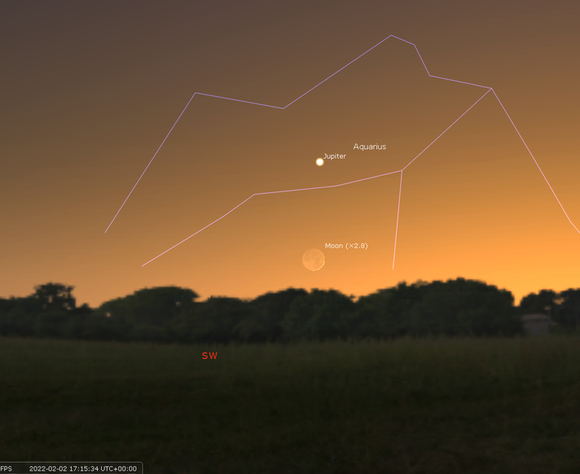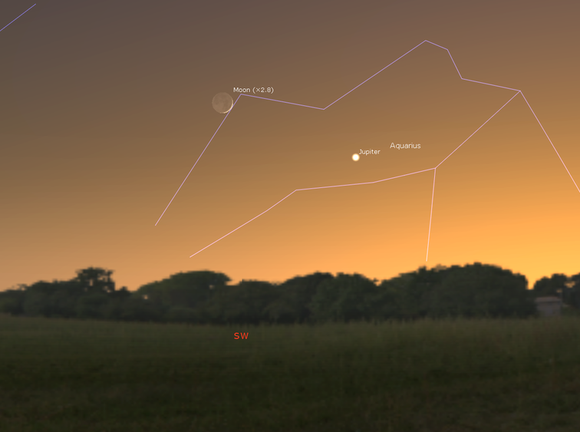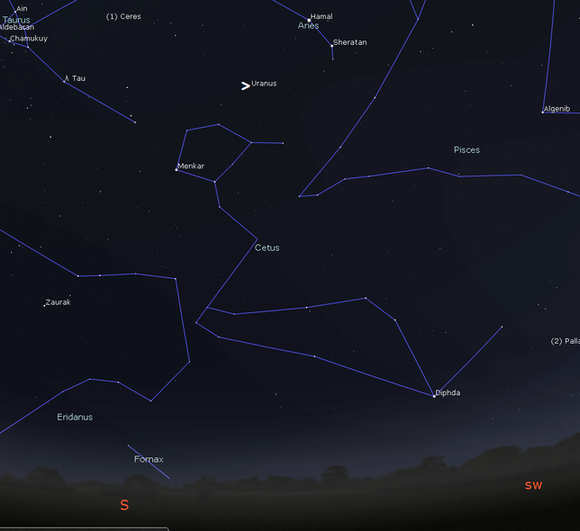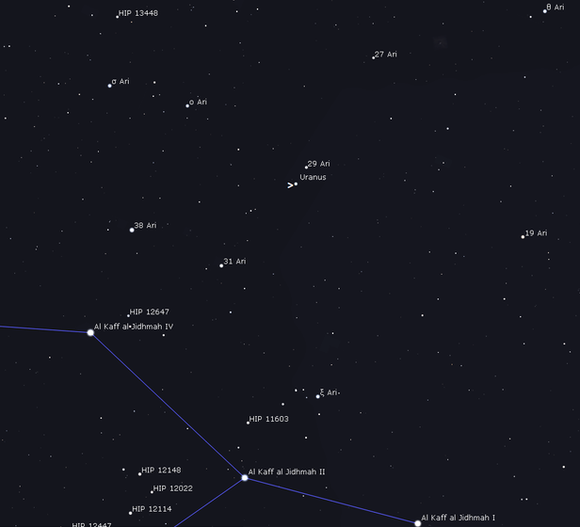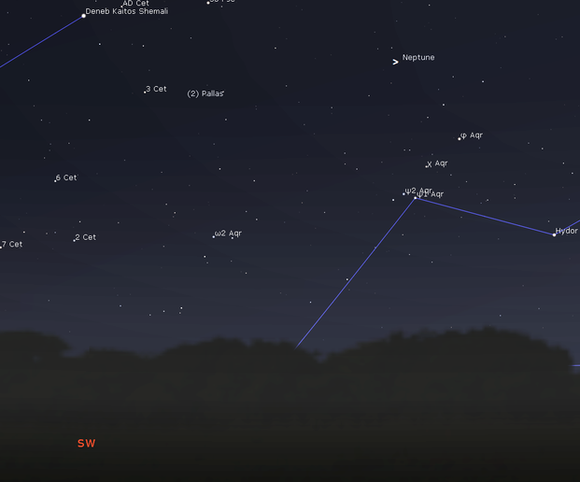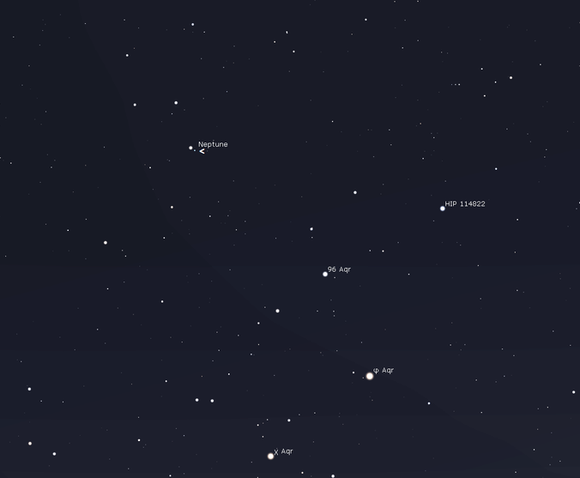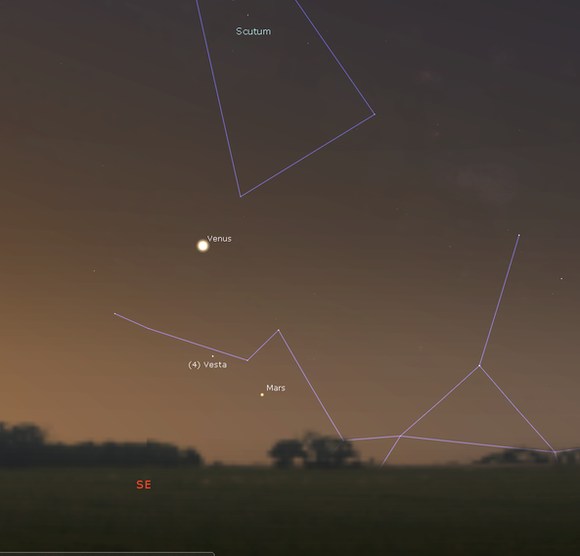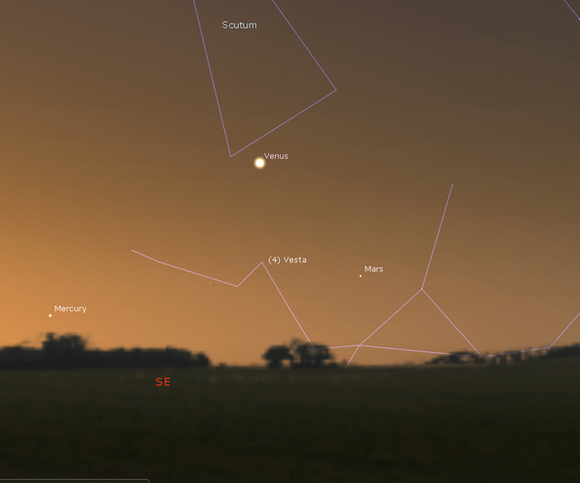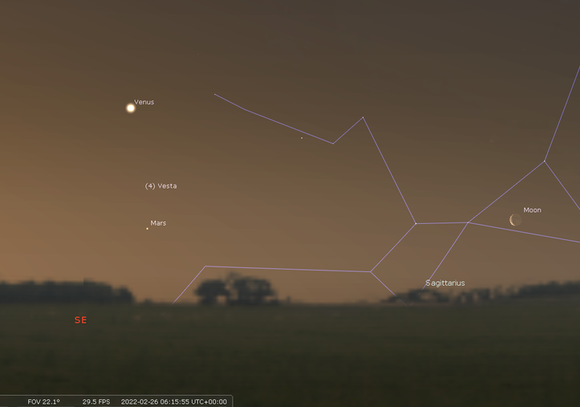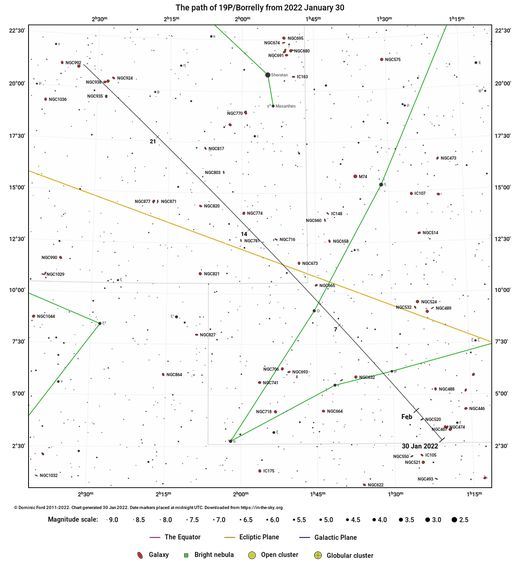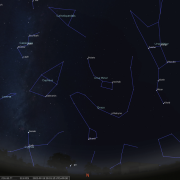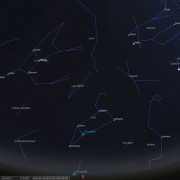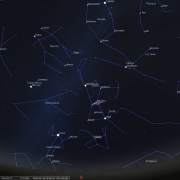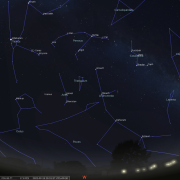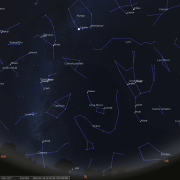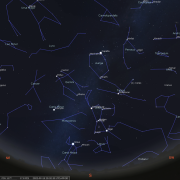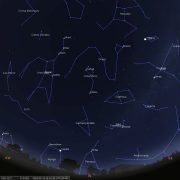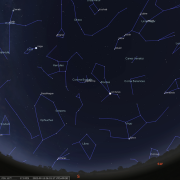In this month's Sky Notes:
Planetary Skylights - Brief
Jupiter is the sole naked eye planet visible in the evening sky, but it too succumbs as we head into the second half of February. Neptune waits at the exit door, whilst Uranus can be tracked down with augmented eyes only. Home to richer pickings, the dawn sky hosts Venus, Mars and Mercury.
 Jupiter bids farewell this month, drawn inexorably down into the bright evening twilight and later in the month setting before it becomes fully dark. Given a clear SW aspect observers in the UK will notice Jupiter low in the SW sky for the first 10 days of February around 17:15hrs, thereafter it becomes increasingly challenging to observe at all. Look for a 2 day crescent moon below Jupiter on the 2nd. By the following evening the moon has slipped by Jupiter residing upper left of the planet. Technically speaking Jupiter does not reach solar conjunction until early next month, ending this current long apparition cycle. Jupiter will return to the dawn sky by spring but won't become noticeable there until April.
Jupiter bids farewell this month, drawn inexorably down into the bright evening twilight and later in the month setting before it becomes fully dark. Given a clear SW aspect observers in the UK will notice Jupiter low in the SW sky for the first 10 days of February around 17:15hrs, thereafter it becomes increasingly challenging to observe at all. Look for a 2 day crescent moon below Jupiter on the 2nd. By the following evening the moon has slipped by Jupiter residing upper left of the planet. Technically speaking Jupiter does not reach solar conjunction until early next month, ending this current long apparition cycle. Jupiter will return to the dawn sky by spring but won't become noticeable there until April.
 Uranus remains well placed for observation with 'augmented eyes' (binoculars or Telescope) in the evening sky. As darkness falls it is located in the SSW 50 degrees in altitude in the southern reaches of Aries, (it's actually closer to the head of Cetus) and well below the crooked line of stars marking Aries itself. This area of sky is largely devoid of naked eye stars so zeroing in on the exact location can be a little tricky. Roughly speaking it lies 10 degrees below the chief star in Aries - Hamal. The nearest apparent stars through binoculars are omicron Ari and 29 Ari, both at magnitude 5.7. Uranus currently sits near the latter. At magnitude +5.85 Uranus is technically visible to the naked eye, but only from very dark locations and with good knowledge of the stellar neighbourhood. By the end of February Uranus is setting just after 23:00hrs.
Uranus remains well placed for observation with 'augmented eyes' (binoculars or Telescope) in the evening sky. As darkness falls it is located in the SSW 50 degrees in altitude in the southern reaches of Aries, (it's actually closer to the head of Cetus) and well below the crooked line of stars marking Aries itself. This area of sky is largely devoid of naked eye stars so zeroing in on the exact location can be a little tricky. Roughly speaking it lies 10 degrees below the chief star in Aries - Hamal. The nearest apparent stars through binoculars are omicron Ari and 29 Ari, both at magnitude 5.7. Uranus currently sits near the latter. At magnitude +5.85 Uranus is technically visible to the naked eye, but only from very dark locations and with good knowledge of the stellar neighbourhood. By the end of February Uranus is setting just after 23:00hrs.
 Residing just within the borders of Aquarius and not far below the faint loop of stars marking the western fish in Pisces, early February will be the final opportunity to spot Neptune for a few months before it's lost to solar glare after mid month. Neptune can be located just over 4 degrees north-east of the star Phi aqr (mag +4.2), the nearest visible naked eye star, or just over two degrees from 96 aqr (mag+5.5) the nearest 'bright' binocular star. Neptune is approximately 4.3 billion km (2.7 billion miles) from Earth and at magnitude +7.8 will require at least a decent pair of binoculars to spot it. In reality however, a telescope of 100mm aperture will be needed to positively identify the tiny blue/grey disk, which is less than 2 arc seconds across. Perhaps view on Feb 4th when a crescent moon sits 5 degrees below Neptune (a 10 x 50 binocular field)
Residing just within the borders of Aquarius and not far below the faint loop of stars marking the western fish in Pisces, early February will be the final opportunity to spot Neptune for a few months before it's lost to solar glare after mid month. Neptune can be located just over 4 degrees north-east of the star Phi aqr (mag +4.2), the nearest visible naked eye star, or just over two degrees from 96 aqr (mag+5.5) the nearest 'bright' binocular star. Neptune is approximately 4.3 billion km (2.7 billion miles) from Earth and at magnitude +7.8 will require at least a decent pair of binoculars to spot it. In reality however, a telescope of 100mm aperture will be needed to positively identify the tiny blue/grey disk, which is less than 2 arc seconds across. Perhaps view on Feb 4th when a crescent moon sits 5 degrees below Neptune (a 10 x 50 binocular field) Dawn Planets
 Apparent by 06:00hrs during the first week of February, Venus, at magnitude -4.6 is highly noticeable as the 'morning star', dominating the SE aspect of the sky. The optimum viewing period is 06:40hrs - 07:05hrs, but the observer should view earlier by a few minutes each day, which by the month's end equates to 06:15hrs. Note that by the time twilight starts to drown out Venus it reaches a similar altitude above SE horizon each day, but drifts more to SSE over the course of the month. Through the eyepiece Venus exhibits a distinct crescent phase at the start of February, which grows to almost quarter by the end of February. There will be little else to observe on the disk which is perpetually covered by a duvet of cloud. A slim crescent moon resides off to the right of Venus and Mars on Feb 26th.
Apparent by 06:00hrs during the first week of February, Venus, at magnitude -4.6 is highly noticeable as the 'morning star', dominating the SE aspect of the sky. The optimum viewing period is 06:40hrs - 07:05hrs, but the observer should view earlier by a few minutes each day, which by the month's end equates to 06:15hrs. Note that by the time twilight starts to drown out Venus it reaches a similar altitude above SE horizon each day, but drifts more to SSE over the course of the month. Through the eyepiece Venus exhibits a distinct crescent phase at the start of February, which grows to almost quarter by the end of February. There will be little else to observe on the disk which is perpetually covered by a duvet of cloud. A slim crescent moon resides off to the right of Venus and Mars on Feb 26th.
 Mercury, is also visible in the February dawn sky, but for UK observers, hugs the SE horizon for the first two weeks and is lost again in bright twilight after that. You will therefore require a flat horizon to spot Mercury, which resides lower left of Venus. The optimum time to spot the ever elusive 'messenger of the Gods' is between Feb 6th and 13th @ 06:45 to 07:00hrs, scanning just a few degrees above the ESE horizon. At mag +0.4 Mercury will appear reasonably bright (brighter than Mars - which lies some 14 degrees to the right) and grows brighter as the apparition progresses, but also drops lower.
Mercury, is also visible in the February dawn sky, but for UK observers, hugs the SE horizon for the first two weeks and is lost again in bright twilight after that. You will therefore require a flat horizon to spot Mercury, which resides lower left of Venus. The optimum time to spot the ever elusive 'messenger of the Gods' is between Feb 6th and 13th @ 06:45 to 07:00hrs, scanning just a few degrees above the ESE horizon. At mag +0.4 Mercury will appear reasonably bright (brighter than Mars - which lies some 14 degrees to the right) and grows brighter as the apparition progresses, but also drops lower.
 Mars remains stubbornly close to the SE horizon in the dawn sky located lower right of brilliant Venus. At magnitude +1.5, Mars won't be anywhere near as bright as Venus, resembling an amber hued star. View around 07:00hrs over the first week of February, 06:30 - 06:45hrs around mid month and 06:00 - 06:15hrs by the month's end. Careful observation of the course of February will reveal that Mars is slowly tracking back due SE to a position below Venus. Don't expect to see a great deal at all through a telescope from UK shores, Mars is still way too low and distant. It's time in the limelight will arrive, but not until the end of 2022. A Moon resides off to the right of Mars on Feb 26th.
Mars remains stubbornly close to the SE horizon in the dawn sky located lower right of brilliant Venus. At magnitude +1.5, Mars won't be anywhere near as bright as Venus, resembling an amber hued star. View around 07:00hrs over the first week of February, 06:30 - 06:45hrs around mid month and 06:00 - 06:15hrs by the month's end. Careful observation of the course of February will reveal that Mars is slowly tracking back due SE to a position below Venus. Don't expect to see a great deal at all through a telescope from UK shores, Mars is still way too low and distant. It's time in the limelight will arrive, but not until the end of 2022. A Moon resides off to the right of Mars on Feb 26th.
Meteors- The 'fireball' season

There are no recognised meteor showers of note during February, but you may still spot the odd sporadic meteor. The Alpha Aurigids are a very minor shower running from mid January thru' to mid February, however numbers are indistinguishable from sporadic levels; barely 2-5 per hour. That said, meteors witnessed at this time of year are quite often bright, indeed it has been suggested that late January to March; the 'fireball' season', may be a very old depleted shower of similar nature to the Geminids, composed of more dense, rocky debris. If you do spot a meteor speeding away from near Capella (alpha aurigid) make a mental note, otherwise it's just a sporadic with no name, but you could call it AL if you want to!
Comet 19P/Borrelly
Comet Borrelly reaches perihelion on February 1st at a distance of 1.3AU from the Sun. The comet will lie in south-eastern Pisces around 9 degrees east of its chief star Alrescha (mag +3.8). Observers tracking Borrelly should do so as soon as true darkness falls just before 19:00hrs. It will then be approximately 34 degrees up in the SW sky. At a predicted brightness of +8 you will not see Borrelly with the naked eye, however binoculars, telescopes or imaging devices will pick it out. Imaging devices (preferably on tracking platforms) will reveal a quite large coma and faint tail. Binoculars and scopes will yield a fuzzy blob like feature. The comet is moving north-eastwards through Pisces at around 2.3 arc seconds per minute - so relatively fast and enters into Aries on Feb 10th. By the end of the month Comet Borrelly will lie around 8 degrees east of Aries chief star, Hamal. If viewed at 19:00hrs the comet will still be above the west horizon by over 30 degrees. On February 21st it will be 4 degrees northeast of Uranus.
For accurate charts and position of comets please visit https://theskylive.com
February 2022 Sky Charts
Additional Image Credits:
- Planets and Comets where not otherwise mentioned: NASA
- Sky Charts: Stellarium Software and Starry Night Pro Plus 8
- Log in to post comments

